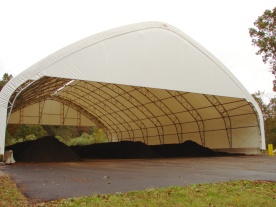 The agricultural composting facility has been operating since late-August 2010 and, according to Farm Services, is composting more manure and leaf waste than was originally projected – at the rate of about 800 tons of agricultural waste per year.
The agricultural composting facility has been operating since late-August 2010 and, according to Farm Services, is composting more manure and leaf waste than was originally projected – at the rate of about 800 tons of agricultural waste per year.
The facility is state-of-the-art, especially for preventing stormwater runoff to surface water and leaching of nutrients into groundwater.
Although the sale of compost was initially limited to private companies, it has also been sold to the public or dedicated to land mitigation projects on campus in past years. For purchasing information, see "Friday and Saturday Compost Sales" below. In the past, the compost facility has sold out of marketable material in less than one week! The revenue generated from the compost sales goes towards offsetting labor costs, the fuel cost of the compost turner (which is very efficient for a machine that large), and towards fuel costs of the pay loader.
Video of UConn's Agricultural Composting Facility
Updated: 4/28/2020
Friday/Saturday Compost Sales
Stay tuned for the announcement next spring regarding 2021 compost sales!
Project History
 Agricultural composting has been a long-time vision of the College of Agriculture & Natural Resources with 10 proposals being submitted since 1992.
Agricultural composting has been a long-time vision of the College of Agriculture & Natural Resources with 10 proposals being submitted since 1992.
- 2001: Ohio State University study of UConn's nutrient composition and possible facility design.
- 2005: 400+ petition President Austin to construct a compost facility. A Task Force is appointed for further investigation.
- 2006: Compost Facility Task Force issues a comprehensive report and recommends the first site.
- August 2007: Board of Trustees approves $600,000 capital budget for construction of the facility.
- Fall 2007: Public informational meetings are planned and the design process begins.
- December 2007: Informational meeting with neighbors is canceled and alternative site analysis begins.
- Fall 2008: New proposed sites are selected and a public informational open house was held in November.
- Spring 2010+: Facility constructed and fully operational.
Benefits of Composting Compared with Spreading Raw Manure
- Reduction in Odor
-
- There is little to no odor when applying compost to agricultural land, especially as compared to use of non-composted manure.
- Reduction in Volume
- Semi-solid manure, which is a mix of manure and sawdust, is reduced in volume by 40-50% after composting. Our horse manure is an example of semi-solid manure. Liquid manure, like the manure from our dairy cows, is typically reduced in volume by about 80% after composting.
- Suppression of plant pathogens in the soil
- Application of compost to soils has been shown to suppress plant pathogens in the soil. There is no evidence that application of manure to soils suppresses plant pathogens.
- Reduction of weed seeds in manure
- Composting substantially reduces the number of weed seeds in semi-solid manure.
- Reduction in soluble nutrients
- Environmental benefits: Composting manure reduces the soluble nutrient content of the manure to almost zero. Soluble nitrogen in manure is easily leached to ground water and soluble phosphorus in manure easily runs off the soil surface to pollute streams, lakes, and ponds. Application of compost to agricultural fields substantially reduces the amount of nitrogen and phosphorus in leachate and runoff from the fields.
- Other benefits include:
- Reducing emissions of greenhouse gases
- Watershed protection due to cleaner agricultural run-off
- Excellent research opportunity with 200+ grants funded in the USDA Sustainable Agriculture program in the past 15 years for compost-related research
- Valuable teaching tool for graduate and undergraduate education
- Opportunities for use by extension offices for demonstrations and training of farmers, municipal employees, etc.
- Demonstration of leadership in best agricultural practices and environmental responsibility
- Cost savings from decreased purchase of mulch and fertilizer